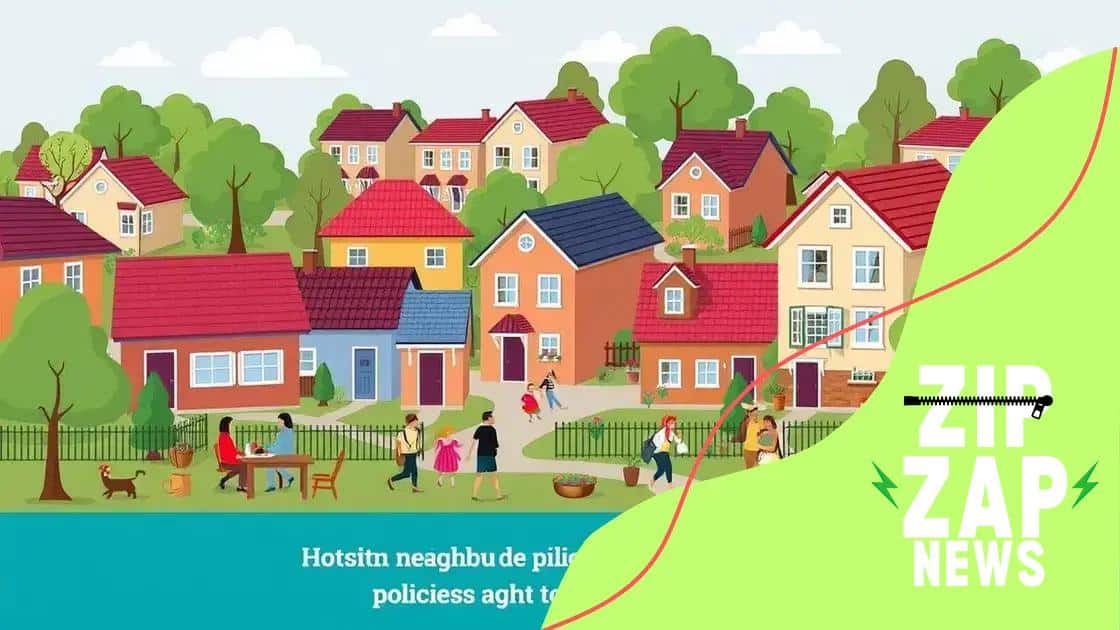How federal government is addressing housing insecurity

The federal government addresses housing insecurity through programs that promote affordable housing, support local initiatives, and foster community collaborations to create stable living conditions for vulnerable populations.
How federal government is addressing housing insecurity is crucial as millions face challenges in securing stable housing. In this article, we’ll uncover the various approaches taken and their effects on communities.
Understanding housing insecurity
Understanding housing insecurity is vital to grasping the challenges faced by many families and individuals today. This issue can stem from a variety of factors, including economic instability, rising rent prices, and insufficient affordable housing options.
What is Housing Insecurity?
Housing insecurity refers to the condition where individuals or families are at risk of losing their homes or are in unstable living situations. It encompasses a wide range of scenarios, from those experiencing homelessness to those living in overcrowded or substandard conditions.
Key Factors Contributing to Housing Insecurity
- Economic Challenges: Many people face financial difficulties that hinder their ability to pay rent or mortgages.
- High Housing Costs: The increasing prices of homes and rentals make it difficult for low-income families to find affordable options.
- Lack of Support Services: Limited access to resources like job training and financial counseling can exacerbate housing insecurity.
Furthermore, systemic issues such as discrimination and zoning laws can also play a role in exacerbating these challenges. For instance, certain communities may lack access to necessary resources, making it harder for residents to achieve stable housing.
Public awareness about housing insecurity is crucial. By understanding the complexities of this issue, communities can come together to advocate for better policies and support systems. Engaging in discussions about housing policy can help promote solutions that address the root causes.
Current federal programs in place
Current federal programs play a crucial role in addressing housing insecurity across the nation. These initiatives are designed to provide assistance to individuals and families who are struggling to secure stable housing.
Federal Housing Assistance Programs
One of the primary methods involves subsidizing rents and ensuring that low-income families have access to affordable housing. Programs like the Housing Choice Voucher Program help cover the cost of rent, enabling families to afford homes in their desired neighborhoods.
Emergency Housing Assistance
- Emergency Solutions Grant Program: This program offers funds to homeless prevention services, including rapid rehousing.
- National Housing Trust Fund: Allocates resources for building, rehabilitating, and operating rental housing for very low-income households.
- Community Development Block Grants: These grants provide funding to local governments for a variety of housing and community development needs.
Additionally, there are state-specific programs that further enhance the federal efforts. These local initiatives are often more tailored to meet the unique needs of communities. They can include assistance with utility bills, housing counseling, and legal aid for tenants facing eviction.
It’s important to raise awareness about these federal programs, as many individuals who qualify may not be aware of the resources available to them. Understanding these options can lead to more stable living situations for those in need.
Impact of housing policies on communities

The impact of housing policies on communities is profound and multifaceted. These policies can shape the overall health, stability, and growth of neighborhoods, influencing everything from property values to community cohesion.
Positive Effects of Housing Policies
When designed effectively, housing policies can lead to numerous benefits. They can promote affordable housing options for low-income families, helping to reduce overall poverty levels. Additionally, policies that enable mixed-income housing can encourage diverse community interactions.
Key Outcomes of Effective Policies
- Improved Access to Resources: Access to better schools, healthcare, and employment opportunities can arise from well-planned housing developments.
- Economic Growth: Housing policies that stimulate local construction projects can lead to job creation and increased economic activity.
- Community Stability: Stable housing supports families, which in turn fosters stronger community ties and reduces crime.
On the contrary, ineffective policies can have detrimental effects. For instance, zoning restrictions might limit the construction of affordable housing, pushing low-income families further out of urban centers. This displacement can lead to increased travel times for workers, impacting their employment possibilities and quality of life.
Moreover, communities facing housing insecurity often experience reduced investments. When families can’t afford stable housing, it can create a cycle of poverty that is hard to break. Understanding the impact of housing policies allows for better advocacy and improvement efforts, ensuring that all community members can thrive.
Collaborations with local governments
Collaborations with local governments are essential in tackling housing insecurity. These partnerships bridge the gap between federal initiatives and community needs, ensuring that assistance reaches those who need it most.
Role of Local Governments
Local governments play a pivotal role in implementing housing policies. They are often the frontline responders to housing crises, making their involvement crucial for effective solutions. By working closely with federal programs, local agencies can tailor their services to fit the unique challenges of their communities.
Key Areas of Collaboration
- Funding and Resources: Local governments often manage federal funds, allocating them to housing projects that best suit community needs.
- Policy Development: Collaborating on policies ensures that they address local issues, such as zoning laws and building regulations.
- Outreach and Education: They provide information to residents about available housing programs, helping to raise awareness of resources.
These collaborations not only enhance the effectiveness of housing programs but also build a sense of community. When local governments partner with community organizations, they can leverage additional resources and support networks. This can lead to innovative solutions that directly address the needs of residents facing housing insecurity.
Moreover, successful collaborations can involve various stakeholders, including nonprofits, developers, and businesses. By pooling resources and expertise, communities can implement comprehensive strategies that promote sustainable housing solutions.
Future strategies for affordable housing
Future strategies for affordable housing are crucial in addressing the ongoing issues of housing insecurity. As populations grow and cities evolve, innovative solutions must be considered to ensure that everyone has access to safe and stable homes.
Embracing Technology
One of the most promising strategies is leveraging technology to streamline housing development. For example, using data analytics can help identify areas most in need of affordable housing and predict future demands. Additionally, innovations in construction techniques, such as modular building and 3D printing, can reduce costs and time frames for completing housing projects.
Incentivizing Developers
- Tax Credits: Providing tax incentives to developers who build affordable units can encourage more participation in the market.
- Public-Private Partnerships: Collaborating with private firms can lead to more funding and resources dedicated to affordable housing projects.
- Streamlining Regulations: Reducing bureaucratic obstacles can make it easier for projects to move from planning to completion, facilitating the growth of affordable housing.
Moreover, community involvement plays a vital role in shaping future housing strategies. Engaging residents in the planning process ensures that developments meet the actual needs of the community. Regular forums and workshops can provide a platform for residents to voice their concerns and suggestions. Recognizing the voices of people directly affected by the housing crisis can lead to more effective and inclusive policies.
Another key aspect is focusing on sustainable practices. Incorporating green building materials and energy-efficient designs not only lowers long-term costs for residents but also benefits the environment. Sustainable developments can be a win-win for communities, fostering both economic growth and ecological responsibility.
In conclusion, addressing housing insecurity requires a combination of innovative strategies and strong collaborations. By leveraging technology, incentivizing developers, and fostering community involvement, we can create sustainable solutions that benefit everyone. Future efforts must focus on making affordable housing accessible, enhancing community stability, and ensuring all voices are heard. Together, we can shape a brighter future for housing for all.
FAQ – Frequently Asked Questions about Housing Insecurity
What are the main causes of housing insecurity?
Common causes include high housing costs, low income, unemployment, and lack of affordable housing options.
How can technology help in solving housing issues?
Technology can streamline development processes, analyze housing needs, and create efficient management systems for affordable housing.
What role does community involvement play in housing solutions?
Community involvement ensures that housing solutions meet local needs, fostering more inclusive and effective policies.
Why is sustainable building important for affordable housing?
Sustainable building reduces long-term costs for residents and supports environmental conservation, making it essential for future developments.





